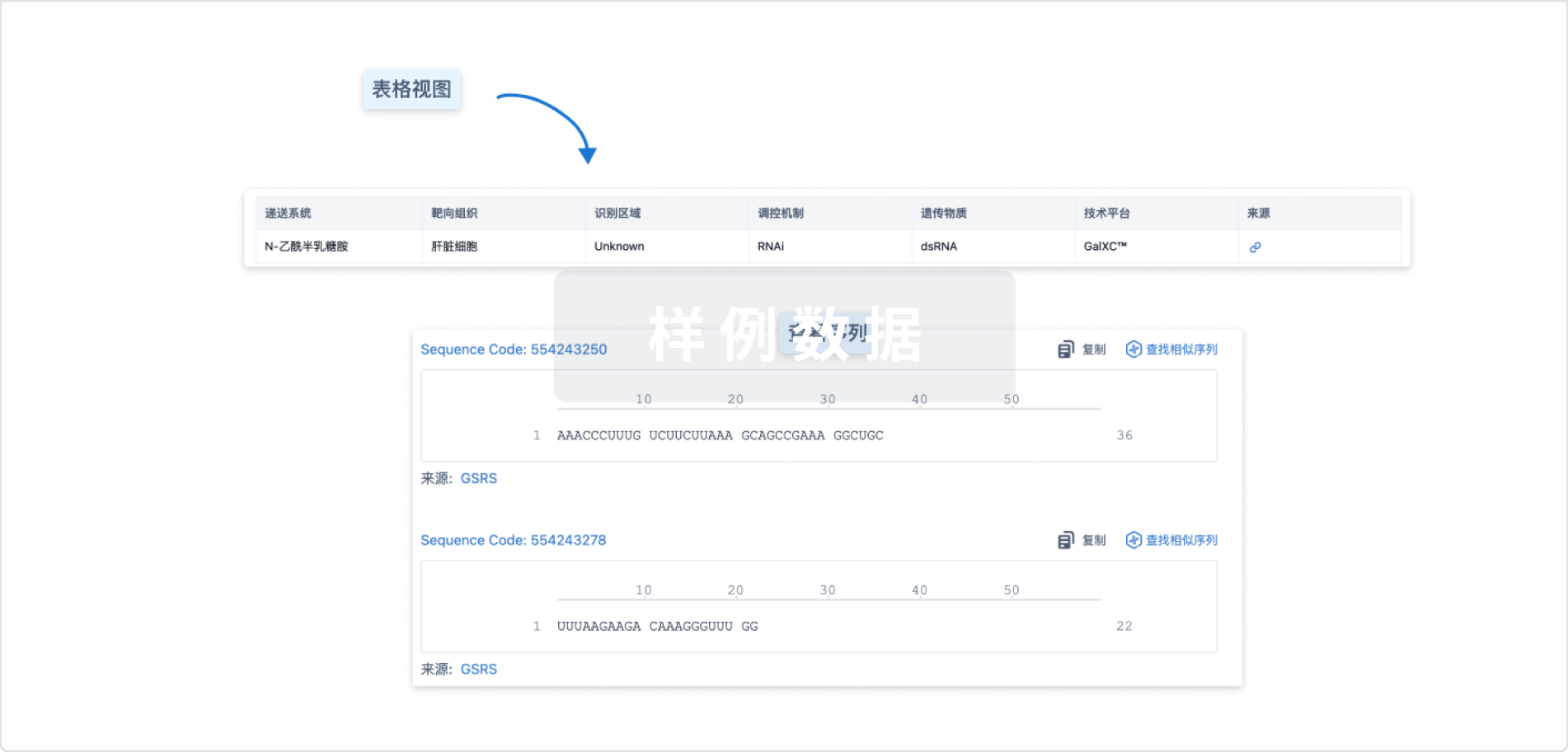预约演示
更新于:2025-12-06
ATL-201
更新于:2025-12-06
概要
基本信息
非在研机构- |
权益机构- |
最高研发阶段临床前 |
首次获批日期- |
最高研发阶段(中国)- |
特殊审评- |
结构/序列
使用我们的RNA技术数据为新药研发加速。
登录
或

关联
100 项与 ATL-201 相关的临床结果
登录后查看更多信息
100 项与 ATL-201 相关的转化医学
登录后查看更多信息
100 项与 ATL-201 相关的专利(医药)
登录后查看更多信息
2
项与 ATL-201 相关的新闻(医药)2025-02-10
·创鉴汇
▎药明康德内容团队编辑
据创鉴汇不完全统计,春节假期前后两周(1月27日至2月9日)全球大健康领域共披露融资事件52起,总额超136亿元。按照金额划分,亿元及以上融资25起。按照已披露的融资轮次划分,早期融资(B轮以前)19起,中后期融资(B轮及以后)16起。生物医药领域共18家公司获融资,其中4家完成IPO。
#01
Metsera登陆纳斯达克
关键词:多肽
最新融资:约2.75亿美元IPO
1月30日消息,Metsera宣布登陆纳斯达克,总收益预计约为2.75亿美元。Metsera是一家临床阶段的生物医药公司,专注于营养刺激激素(NuSH)类似物多肽的研发。Metsera还拥有新型多肽脂质化平台和口服多肽递送平台,新型多肽脂质化平台使多肽能够同时与白蛋白和药物靶标结合,从而使半衰期接近白蛋白,并比其他NuSH肽半衰期高出2到3倍。口服多肽递送平台集成了多种专有技术,以远低于竞争对手NuSH口服肽的剂量水平提供治疗效果,释放了类似注射剂的疗效和耐受性的潜力。
#02
Sionna Therapeutics登陆纳斯达克
关键词:小分子药物
最新融资:约1.91亿美元IPO
2月6日,Sionna Therapeutics宣布登陆纳斯达克,总收益预计约为1.91亿美元。Sionna Therapeutics是一家临床阶段的生物制药公司,其使命是通过开发使跨膜传导调节因子(CFTR)蛋白功能正常化的新型药物来彻底改变当前的囊性纤维化(CF)治疗模式。Sionna的目标是为CF患者提供差异化的药物,通过直接稳定 CFTR的核苷酸结合域1(NBD1)将其CFTR蛋白功能恢复到尽可能接近正常的水平。Sionna已经展示了包括来自人支气管上皮细胞(CFHBE)模型数据在内的临床前数据,这些数据显示其NBD1稳定剂在与互补调节剂联合使用时,能恢复ΔF508-CFTR的成熟、运输和功能至野生型水平。
#03
Maze Therapeutics登陆纳斯达克
关键词:小分子药物
最新融资:约1.4亿美元IPO
2月6日,Maze Therapeutics宣布登陆纳斯达克,总收益预计约为1.4亿美元。Maze Therapeutics 是一家临床阶段的生物制药公司,利用人类遗传学的力量为常见疾病患者开发新型小分子精准药物,重点关注肾脏、心血管和相关代谢,包括肥胖症。其产品管线MZE829是一款口服小分子抑制剂,针对APOL1肾病患者开发。2024年10月公布的1期临床试验结果显示药物耐受性良好,2024年11月已启动2期临床试验,预计2025年第一季度完成首例患者给药,2026年第一季度获得概念验证数据。
#04
亚盛医药登陆纳斯达克
关键词:小分子药物
最新融资:约1.26亿美元IPO
亚盛医药宣布,公司已于1月24日晚间正式在纳斯达克全球市场上市,所得款项总额预期约为126.4百万美元。亚盛医药致力在肿瘤等治疗领域开发创新药物,以解决肿瘤等领域患者尚未满足的临床需求。成立至今,公司得益于其在基于结构的药物设计方面的技术专长以及其新药发现引擎,致力于研发透过抑制Bcl-2、MDM2-p53等细胞凋亡通路关键蛋白的抑制剂,新一代针对癌症治疗中出现的激酶突变体的抑制剂等解决未满足的医疗需求。目前,亚盛医药有11项已完成或进行中的美国及/或国际注册研究。
#05
AdvanCell完成1.12亿美元C轮融资
关键词:放射性配体疗法
最新融资:1.12亿美元C轮
本轮投资机构:SV Health Investors、SymBiosis、Tenmile、晨兴创投、赛诺菲风险投资公司等
2月3日,AdvanCell公司宣布成功完成了超额认购的1.12亿美元C轮融资。这笔融资将助力AdvanCell持续扩大其生产能力,加速其放射性配体疗法管线的临床开发。目前,AdvanCell正在为1/2期临床试验TheraPb的最高剂量组招募转移性前列腺癌患者。该试验旨在评估在研疗法ADVC001的安全性和有效性。ADVC001为一款潜在“best-in-class”的放射性配体疗法,可通过与前列腺特异性膜抗原(PSMA)结合的配体靶向递送释放α粒子的铅212同位素。
#06
Atalanta完成9700万美元B轮融资
关键词:RNAi
最新融资:9700万美元B轮
本轮投资机构:EQT Life Sciences、F-Prime Capital、GHR Foundation、诺华风险基金、Sanofi Ventures等
1月28日,Atalanta Therapeutics宣布完成9700万美元的B轮融资,以支持公司针对KCNT1相关癫痫和亨廷顿病的RNAi药物的1期临床试验。该公司独有的创新di-siRNA药物设计在临床前研究中显示出在大脑和脊髓中的广泛分布以及在大脑中的显著持久性。单次给药di-siRNA显示出6个月或更长时间的基因沉默潜力,这可能在临床环境中允许每年一次或两次给药。
Atalanta Therapeutics的研发管线中包含多款治疗中枢神经系统疾病的RNAi疗法。其中,ATL-201是用于治疗KCNT1相关癫痫的在研疗法,旨在降低KCNT1水平并正常化神经元的兴奋性。临床前研究表明,ATL-201能够显著减少癫痫发作,并改善行为,且具有良好的持久性和耐受性。
#07
Helicore完成6500万美元A轮融资
关键词:GIP拮抗剂
最新融资:6500万美元A轮
本轮投资机构:Versant Ventures、奥博资本
1月28日,Helicore Biopharma公司宣布走出隐匿模式,并完成6500万美元A轮融资。Helicore公司聚焦于开发潜在“first-in-class”葡萄糖依赖性促胰岛素多肽(GIP)拮抗剂,用于治疗肥胖症和相关健康问题。其研发进度最快的候选疗法HCR-188是一款处于临床开发阶段的抗GIP单克隆抗体。HCR-188与GLP-1药物联用,在临床前研究中显示可让动物优先减少脂肪而不是瘦体质量(lean mass)。与GLP-1药物相比,可能带来更高质量的体重减轻。该公司的研发管线中还包括靶向GIP的抗体偶联药物,GLP-1药物以及组合疗法,旨在针对特定肥胖患者亚群。
#08
Auron完成2700万美元B轮融资
关键词:蛋白降解疗法
最新融资:2700万美元B轮
本轮投资机构:Casdin Capital、Data Collective Bio、Franklin Berger、Mubadala Capital、启明创投(美国)等
2月4日,Auron Therapeutics公司宣布完成2700万美元的B轮融资。融资获得的资金将用于推进AUTX-703在急性髓系白血病(AML)患者中进行的1期临床概念验证试验,该试验将于今年第一季度开始患者招募。AUTX-703是一款潜在“first-in-class”口服KAT2A/B蛋白降解剂,由Auron通过其AURIGIN平台发现并开发。此外,部分资金还将用于评估靶向KAT2A/B在治疗自身免疫性疾病中的潜力,并推动利用该公司独有的AURIGIN药物发现平台针对上皮间质转化(EMT)肿瘤靶点的药物研发工作。
读者们请星标⭐创鉴汇,第一时间收到推送
免责声明:药明康德内容团队专注介绍全球生物医药健康研究进展。本文仅作信息交流之目的,文中观点不代表药明康德立场,亦不代表药明康德支持或反对文中观点。本文也不是治疗方案推荐。如需获得治疗方案指导,请前往正规医院就诊。
版权说明:本文由药明康德内容团队根据公开资料整理编辑,欢迎个人转发至朋友圈,谢绝媒体或机构未经授权以任何形式转发/复制至其他平台。转发授权请在「创鉴汇」微信公众号留言联系我们。
更多数据内容推荐
点击“在看”,分享创鉴汇健康新动态
IPO临床2期
2025-01-28
For five years, Atalanta Therapeutics operated with one investor.
Now, F-Prime Capital is getting a bevy of financial support to propel two of the Boston biotech’s RNAi drugs for rare neurological disorders into human trials.
Atalanta said Tuesday that investors in its $97 million Series B include EQT Life Sciences, the corporate venture arms of Sanofi and Novartis, RiverVest Venture Partners, funds managed by abrdn, Pictet Alternative Advisors, Mirae Asset Financial Group and GHR Foundation.
The oversubscribed funding came at a step-up, CEO Alicia Secor said in an interview, and that was welcome news after the biotech
had layoffs
and lost a partnership with
yearslong collaborator Biogen
last year. Secor said Atalanta regained the rights to two undisclosed preclinical programs it was working on with Biogen, which is currently going through its own reshuffling,
Endpoints News
reported
last week.
Atalanta’s partnership with Roche’s Genentech remains ongoing and is “absolutely thriving,” Secor said.
The startup emerged in
January 2021 with $110 million
by way of F-Prime’s funding and payments from Genentech and Biogen.
The biotech was co-founded by Nobel laureate Craig Mello — one of RNAi’s pioneers — in addition to UMass Chan Medical School’s Anastasia Khvorova and Neil Aronin, an expert in Huntington’s disease and practicing endocrinologist.
In the field of RNAi, Atalanta hopes to distinguish itself with a divalent construct.
“We have two siRNA duplexes joined by a linker,” Secor said. “The chemistry is what imparts different results from anything that has been out there. So what we see is unprecedented knockdown [and] broad distribution across all brain regions.”
Alnylam broke open the field for RNAi medicines, having secured multiple drug approvals since Onpattro’s launch in 2018. Its longtime former CEO, John Maraganore,
revealed a new biotech
last year to work on the next generation of RNAi candidates.
“We feel like we have potentially the best-in-class oligo platform for CNS delivery,” Secor said. “It’s been one of the holy grails. I think oligonucleotides have proven their value. RNAi, as a technology, is really expanding into all different tissue types.”
The neuroscience field, one of the riskiest in clinical development, has seen a resurgence in recent years, but the “universe of CNS targets remains untapped in so many ways,” Secor said. “We know that our technology can basically knock down any transcript in the CNS.”
Atalanta plans to ask health regulators to clear its first two clinical trials later this year for ATL-201 and ATL-101 in patients with KCNT1-related epilepsy and Huntington’s disease, respectively.
A few thousand infants and children in the US, and a similar number in Europe, have the genetic KCNT1 form of epilepsy, which leads to about 20 to 50 seizures per day, Secor said, and the mortality rate is about 50% by age 10.
In preclinical studies in mice with seizures, Atalanta’s therapy showed a 70% reduction in seizures by knocking down the levels of KCNT1 by 50%, according to Secor. She said the “amazing preclinical data” have not yet been made public.
Atalanta is also researching additional targets for Huntington’s, including MSH3, Secor said. It’s workshopping programs in Alzheimer’s disease (CD33 and APOE), pain and other CNS disorders. In pain, it’s looking at trigeminal neuralgia. And it’s pursuing NaV1.7, a sodium channel that’s
been targeted for years
by some pharmas.
Vertex
,
SiteOne Therapeutics
and others are also going after a similar pain-signaling channel called NaV1.8.
“It’s about time we had a revolution in the industry for non-opioid pain solutions,” she said.
寡核苷酸
100 项与 ATL-201 相关的药物交易
登录后查看更多信息
研发状态
10 条进展最快的记录, 后查看更多信息
登录
| 适应症 | 最高研发状态 | 国家/地区 | 公司 | 日期 |
|---|---|---|---|---|
| 癫痫 | 临床前 | 美国 | 2025-01-28 |
登录后查看更多信息
临床结果
临床结果
适应症
分期
评价
查看全部结果
| 研究 | 分期 | 人群特征 | 评价人数 | 分组 | 结果 | 评价 | 发布日期 |
|---|
No Data | |||||||
登录后查看更多信息
转化医学
使用我们的转化医学数据加速您的研究。
登录
或

药物交易
使用我们的药物交易数据加速您的研究。
登录
或

核心专利
使用我们的核心专利数据促进您的研究。
登录
或

临床分析
紧跟全球注册中心的最新临床试验。
登录
或

批准
利用最新的监管批准信息加速您的研究。
登录
或

特殊审评
只需点击几下即可了解关键药物信息。
登录
或

生物医药百科问答
全新生物医药AI Agent 覆盖科研全链路,让突破性发现快人一步
立即开始免费试用!
智慧芽新药情报库是智慧芽专为生命科学人士构建的基于AI的创新药情报平台,助您全方位提升您的研发与决策效率。
立即开始数据试用!
智慧芽新药库数据也通过智慧芽数据服务平台,以API或者数据包形式对外开放,助您更加充分利用智慧芽新药情报信息。
生物序列数据库
生物药研发创新
免费使用
化学结构数据库
小分子化药研发创新
免费使用
